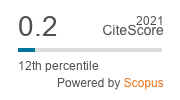Factores asociados a la presencia de bacterias gramnegativas en teléfonos celulares de comerciantes de un mercado
Resumen
Objetivo: Evaluar los factores asociados a la presencia de bacterias gramnegativas en los celulares de los comerciantes del mercado principal de la ciudad de Huánuco, Perú.
Métodos: Se realizó un estudio transversal. La muestra fue de 116 comerciantes y se obtuvo por muestreo probabilístico estratificado. Se tomaron muestras de sus celulares, se cultivaron manualmente y se determinó la sensibilidad con discos de antibiograma. El instrumento fue la tarjeta de colección validada (81 %). Para el análisis se utilizó el software Stata v.16, utilizando ji cuadrado y U de Mann Whitney.
Resultados: El 17,2 % de los celulares tenía crecimiento de bacterias gramnegativas. El análisis bivariado con esta variable encontró que el sexo, el tipo de celular y el mayor tiempo de uso en horario laboral se asociaron estadísticamente (p< 0,05).
Conclusiones: El género femenino, tener celular con teclado y la mayor frecuencia de uso son factores asociados a la presencia de bacterias gramnegativas en celulares de vendedores del mercado de Huánuco, Perú.
Palabras clave
Referencias
Kuriyama A, Fujii H, Hotta A, Asanuma R, Irie H. Prevalence of bacterial contamination of touchscreens and posterior surfaces of smartphones owned by healthcare workers: a cross-sectional study. BMC Infect Dis. 2021; 21(1):681. DOI:10.1186/s12879-021-06379-y
Banawas S, Abdel-Hadi A, Alaidarous M, Alshehri B, Dukhyil AAB, Alsaweed M, et al. Multidrug-Resistant Bacteria Associated with Cell Phones of Healthcare Professionals in Selected Hospitals in Saudi Arabia. Can J Infect Dis Med Microbiol. 2018; 2018:6598918. DOI: 10.1155/2018/6598918
Bhoonderowa A, Gookool S, Biranjia-Hurdoyal SD. The importance of mobile phones in the possible transmission of bacterial infections in the community. J Community Health. 2014; 39(5):965-7. DOI: 10.1007/s10900-014-9838-6
Borer A, Gilad J, Smolyakov R, Eskira S, Peled N, Porat N, et al. Cell Phones and Acinetobacter Transmission. Emerg Infect Dis. 2005; 11(7):1160-1. DOI: 10.3201/eid1107.050221
Galazzi A, Panigada M, Broggi E, Grancini A, Adamini I, Binda F, et al. Microbiological colonization of healthcare workers' mobile phones in a tertiary-level Italian intensive care unit. Intensive Crit Care Nurs. 2019; 52:17-21. DOI: 10.1016/j.iccn.2019.01.005
Astocondor-Salazar L. Betalactamasas: la evolución del problema. Rev Peru Investig En Salud. 2018; 2(2):42-49. DOI: 10.35839/repis.2.2.224
Debnath T, Bhowmik S, Islam T, Hassan Chowdhury MM. Presence of Multidrug-Resistant Bacteria on Mobile Phones of Healthcare Workers Accelerates the Spread of Nosocomial Infection and Regarded as a Threat to Public Health in Bangladesh. J Microsc Ultrastruct. 2018; 6(3):165-9. DOI: 10.4103/JMAU.JMAU_30_18
Loyola S, Gutierrez L, Avendaño E, Severino N, Tamariz J. Multidrug-resistant bacteria isolated from cell phones in five intensive care units: Exploratory dispersion analysis. Germs. 2018; 8(2):85-91. DOI: 10.18683/germs.2018.1135
Nieto-Carhuamaca A, Castañeda-Japan J, Dámaso-Mata B, Panduro-Correa V, Arteaga-Livias K. Bacterial resistance in cell phone cultures of medical students. Infez Med. 2019 [acceso: 20/10/2022]; 27(4):374-379. Disponible en: https://www.infezmed.it/media/journal/Vol_27_4_2019_3.pdf
Egert M, Späth K, Weik K, Kunzelmann H, Horn C, Kohl M, et al. Bacteria on smartphone touchscreens in a German university setting and evaluation of two popular cleaning methods using commercially available cleaning products. Folia Microbiol (Praha). 2015; 60(2):159-64. DOI: 10.1007/s12223-014-0350-2
Cortez-Sandoval V, González R, Ramos D. Detección de enterobacterias productoras de β-lactamasas de espectro extendido (BLEE) aisladas en carne de pollo de mercados de abasto de un distrito de Lima, Perú. Rev Inv Vet Perú 2022; 33(3): e22899. DOI: 10.15381/rivep.v33i3.22899
Akinyemi KO, Atapu AD, Adetona OO, Coker AO. The potential role of mobile phones in the spread of bacterial infections. J Infect Dev Ctries. 2009; 3(8):628-32. DOI: 10.3855/jidc.556
Angadi KM, Misra R, Gupta U, Jadhav S, Sardar M. Study of the role of mobile phones in the transmission of Hospital acquired infections. Med J Dr Patil Univ. 2014; 7(4):435. DOI: 10.4103/0975-2870.135256
Walia SS, Manchanda A, Narang RS, Singh B, Kahlon SS. Cellular telephone as reservoir of bacterial contamination: myth or fact. J Clin Diagn Res JCDR. 2014; 8(1):50-53. DOI: 10.7860/JCDR/2014/6398.3948
Jansen AS, Balbinot GC, Daur AV, da Silva ACF, Nogueira KS, Fernandes T, et al. Detection of potentially pathogenic bacteria on cell phones of hospital and university-based populations in Curitiba, southern Brazil. A cross-sectional study. Sao Paulo Med J Rev Paul Med. 2019; 137(4):343-8. DOI: 10.1590/1516-3180.2018.044305072019
Bodena D, Teklemariam Z, Balakrishnan S, Tesfa T. Bacterial contamination of mobile phones of health professionals in Eastern Ethiopia: antimicrobial susceptibility and associated factors. Trop Med Health. 2019; 47:15. DOI: 10.1186/s41182-019-0144-y
Volkoff SJ, McCumber AW, Anderson DJ, Gunsch CK. Antibiotic-resistant bacteria on personal devices in hospital intensive care units: Molecular approaches to quantifying and describing changes in the bacterial community of personal mobile devices. Infect Control Hosp Epidemiol. 2019; 40(6):717-20. DOI: 10.1017/ice.2019.56
Cicciarella Modica D, Maurici M, D'Alò GL, Mozzetti C, Messina A, Distefano A, et al. Taking Screenshots of the Invisible: A Study on Bacterial Contamination of Mobile Phones from University Students of Healthcare Professions in Rome, Italy. Microorganisms. 2020; 8(7):E1075. DOI: 10.3390/microorganisms8071075
Simmonds R, Lee D, Hayhurst E. Mobile phones as fomites for potential pathogens in hospitals: microbiome analysis reveals hidden contaminants. J Hosp Infect. 2020; 104(2):207-13. DOI: 10.1016/j.jhin.2019.09.010
Bhardwaj N, Khatri M, Bhardwaj SK, Sonne C, Deep A, Kim KH. A review on mobile phones as bacterial reservoirs in healthcare environments and potential device decontamination approaches. Environ Res. 2020; 186:109569. DOI: 10.1016/j.envres.2020.109569
Nakitanda AO, Karlsson P, Löfling L, Cesta CE, Odsbu I. Antimicrobial use in Sweden during the COVID-19 pandemic: prescription fill and inpatient care requisition patterns. BMC Infect Dis. 2022; 22(1):492. DOI: 10.1186/s12879-022-07405-3
Wu YH, Chen CJ, Wu HY, et al. Plastic wrap combined with alcohol wiping is an effective method of preventing bacterial colonization on mobile phones. Medicine (Baltimore). 2020; 99(44):e22910. DOI: 10.1097/MD.0000000000022910
Enlaces refback
- No hay ningún enlace refback.
URL de la licencia: https://creativecommons.org/licenses/by-nc-sa/4.0/deed.es





 La revista es de acceso abierto y gratuito.
La revista es de acceso abierto y gratuito.